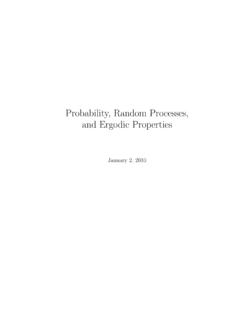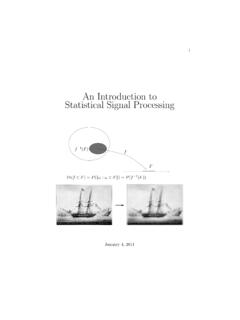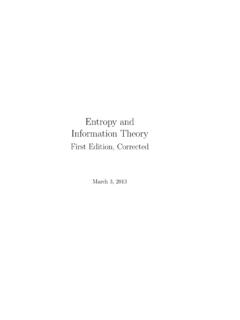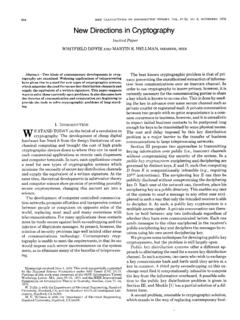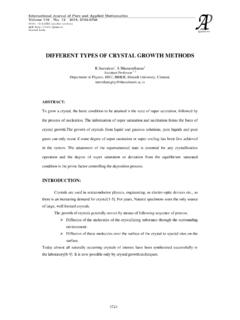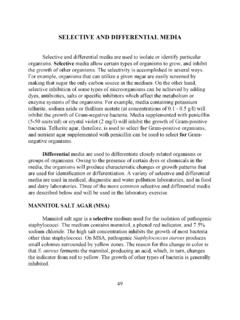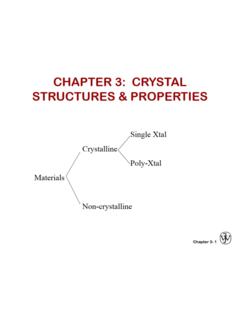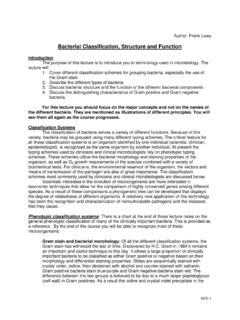Transcription of Optical Physics of Quantum Wells - Stanford EE
1 Optical Physics of Quantum WellsDavid A. B. MillerRm. 4B-401, AT&T Bell LaboratoriesHolmdel, NJ07733-3030 USA1 IntroductionQuantum Wells are thin layered semiconductor structures in which we can observe and controlmany Quantum mechanical effects. They derive most of their special properties from thequantum confinement of charge carriers (electrons and "holes") in thin layers ( 40 atomiclayers thick) of one semiconductor "well" material sandwiched between other semiconductor"barrier" layers. They can be made to a high degree of precision by modern epitaxial crystalgrowth techniques. Many of the physical effects in Quantum well structures can be seen at roomtemperature and can be exploited in real devices. From a scientific point of view, they are also aninteresting "laboratory" in which we can explore various Quantum mechanical effects, many ofwhich cannot easily be investigated in the usual laboratory setting.
2 For example, we can workwith "excitons" as a close Quantum mechanical analog for atoms, confining them in distancessmaller than their natural size, and applying effectively gigantic electric fields to them, bothclasses of experiments that are difficult to perform on atoms themselves. We can also carefullytailor "coupled" Quantum Wells to show Quantum mechanical beating phenomena that we canmeasure and control to a degree that is difficult with this article, we will introduce Quantum Wells , and will concentrate on some of the physicaleffects that are seen in Optical experiments. Quantum Wells also have many interesting propertiesfor electrical transport, though we will not discuss those here. We will briefly allude to some ofthe optoelectronic devices, though again we will not treat them in any to Quantum WellsFirst we will introduce Quantum Wells by discussing their basic Physics , their structure,fabrication technologies, and their elementary linear Optical BAND STRUCTURE AND HETEROSTRUCTURESAll of the Physics and devices that will be discussed here are based on properties of direct gapsemiconductors near the center of the Brillouin zone.
3 For all of the semiconductors of interesthere, we are concerned with a single, S-like conduction band, and two P-like valence bands. Thevalence bands are known as the heavy and light hole bands. Importantly for Quantum Wells , theelectrons in the conduction band, and the (positively charged) "holes" in the valence band behaveas particles with effective masses different from the free electron mass. The simplest " " bandtheory says that the electron effective mass, me, and the light hole effective mass, mlh, areapproximately equal and proportional to the band gap energy. For GaAs, which has a band gapenergy of ~ eV, the actual values are me ~ mo and mlh ~ mo, where mo is the freeelectron mass. The heavy hole effective mass, mhh, is typically more comparable to the freeelectron mass (mhh ~ mo for the most common situation in Quantum Wells ), and does notvary systematically with the band gap Wells are one example of heterostructures - structures made by joining differentmaterials, usually in layers, and with the materials joined directly at the atomic level.
4 When twosemiconductors are joined, it is not clear in advance how the different bands in the two materialswill line up in energy with one another, and their is no accurate predictive theory in , an important experimental quantity is the "band offset ratio"; this is the ratio of thedifference in conduction band energies to the difference in valence band energies. ForGaAs/AlGaAs heterostructures, for example, approximately 67% of the difference in the bandgap energies is in the conduction band offset, and 33% is in the valence band offset, giving aratio 67:33. In this particular material system, both electrons and holes see higher energies in theAlGaAs than in the GaAs, giving a so-called "Type I" system. Heterostructures in whichelectrons and holes have their lowest energies in different materials are called "Type II", butsuch structures will not be considered further in general have many uses.
5 They can be used for advanced electronic devices( , modulation-doped field-effect transistors, heterojunction bipolar transistors, resonanttunneling devices), Optical components ( , waveguides, mirrors, microresonators), andoptoelectronic devices and structures ( , laser diodes, photodetectors, Quantum well andsuperlattice Optical and optoelectronic devices). Although heterostructures may be useful inelectronics, they are crucial in many optoelectronic devices ( , lasers). Perhaps their mostimportant technological aspect may be that they can be used for all of these electronic, Optical ,and optoelectronic purposes, and hence may allow the integration of all of WELL STRUCTURES AND GROWTHA Quantum well is a particular kind of heterostructure in which one thin "well" layer issurrounded by two "barrier" layers. Both electrons and holes see lower energy in the "well"layer, hence the name (by analogy with a "potential well").
6 This layer, in which both electronsand holes are confined, is so thin (typically about 100 , or about 40 atomic layers) that wecannot neglect the fact that the electron and hole are both waves. In fact, the allowed states inthis structure correspond to standing waves in the direction perpendicular to the layers. Becauseonly particular waves are standing waves, the system is quantized, hence the name "quantumwell".There are at least two techniques by which Quantum well structures can be grown, molecularbeam epitaxy (MBE) (Cho 1991), and metal-organic chemical vapor deposition (MOCVD)(Furuya and Miramoto 1990). Both can achieve a layer thickness control close to about oneatomic layer. MBE is essentially a very high vacuum technique in which beams of theconstituent atoms or molecules ( , Ga, Al, or As) emerge from ovens, land on the surface of aheated substrate, and there grow layers of material.
7 Which material is grown can be controlled byopening and closing shutters in front of the ovens. For example, with a shutter closed in front ofthe Al oven, but open shutters in from of the Ga and As ovens, GaAs layers will be the Al shutter will then grow the alloy AlGaAs, with the relative proportion of Ga andAl controlled by the temperatures of the ovens. With additional ovens and shutters for the dopantmaterials, structures of any sequence of GaAs, AlAs, and AlGaAs can be grown with essentiallyarbitrary dopings. MOCVD is a gas phase technique at low pressure ( , 25 torr). In this casethe constituents are passed as gasses ( , trimethylgallium and arsine) over a heated substrate,with the resulting composition being controlled by the relative amounts of the appropriategasses. Hybrid techniques, using the gas sources of MOCVD in a high vacuum molecular beamsystem, also exist, and are known variously as gas-source MBE or chemical beam epitaxy (CBE)(Tsang 1990).
8 Which technique is best depends on the material system and the desired structureor device. Typical structures grown by these techniques might have total thickness of microns,and could have as many as hundreds of layers in are many different materials that can be grown by these techniques, and many of thesehave been used to make Quantum well structures. One significant restriction is that it is importantto make sure that the lattice constants (essentially, the spacing between the atoms) of thematerials to be grown in the heterostructure are very similar. If this is not the case, it will bedifficult to retain a well-defined crystal structure throughout the layers - the growth will not be"epitaxial". The growth is simplest when the lattice constants are identical. Fortunately, AlAsand GaAs have almost identical lattice constants, which means that arbitrary structures can begrown with high quality in this materials system.
9 Another commonly used system is InGaAswith InP; in this case, the proportions of In and Ga are adjusted to give a lattice constant for theternary (three-component) InGaAs alloy that is equal to InP. Use of four component (quaternary)alloys ( , InGaAsP) allows sufficient degrees of freedom to adjust both the lattice constant andthe bandgap energy. Up to a certain critical thickness, which depends on the degree of latticeconstant mismatch, it is possible to grow structures with materials that naturally have differentlattice constants. In this case, the materials grow in a highly strained state but can adopt the locallattice constant and retain good epitaxial crystal structure. Such strained materials are ofincreasing technological importance, although we will not discuss them further partial list of materials used for Quantum well structures includes: III-V's - GaAs/GaAlAson GaAs (Type I), GaSb/GaAlSb on GaSb (Type I), InGaAs/InAlAs on InP (Type I), InAs/GaSb(Type II), InGaAs/GaAs (Type I, strained); II-VI's - HgCdTe/CdTe, ZnSe/ZnMnSe(semimagnetic), CdZnTe/ZnTe (Type 1, strained); IV-VI's - PbTe/PbSnTe; IV - Si/SiGe(strained).
10 Quantum WELL PHYSICSWe can understand the basic properties of a Quantum well through the simple "particle-in-a-box" model. Here we consider Schr dinger's equation in one dimension for the particle ofinterest ( , electron or hole) !2222mddzVzEnnnnIII()(1)where V(z) is the structural potential ( , the " Quantum well" potential) seen by the particlealong the direction of interest (z), m is the particle's (effective) mass, and En and In are theeigenenergy and eigenfunction associated with the n'th solution to the simplest case is shown in Fig. 1. In this "infinite well" case, we presume for simplicitythat the barriers on either side of the Quantum well are infinitely high. Then the wavefunctionmust be zero at the walls of the Quantum Fig. 1 "Infinite" Quantum well and associated solution is then particularly simple:EmnLnAnzLnznz ! "$# !22212 SIS, , ..sin (2)The energy levels (or "confinement energies") are quadratically spaced, and the wavefunctionsare sine waves.
